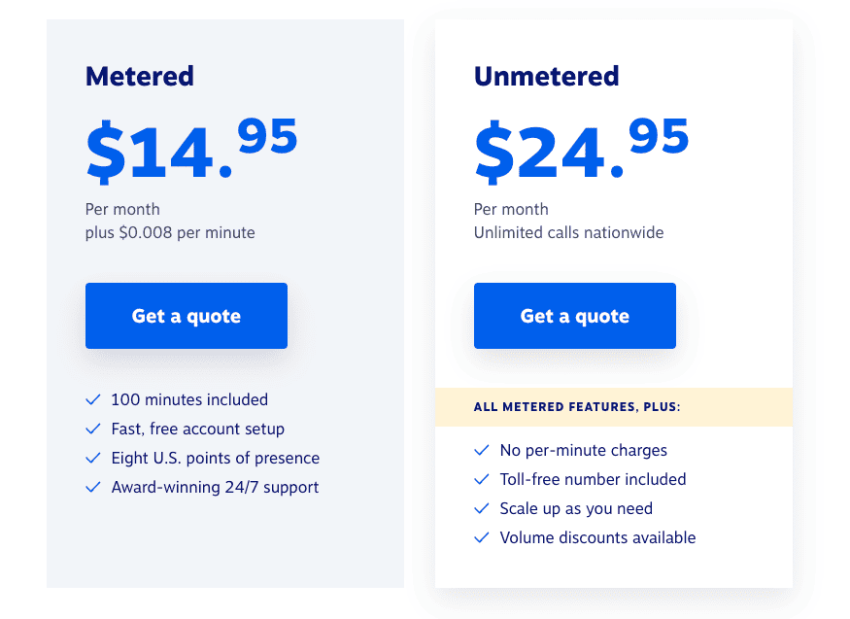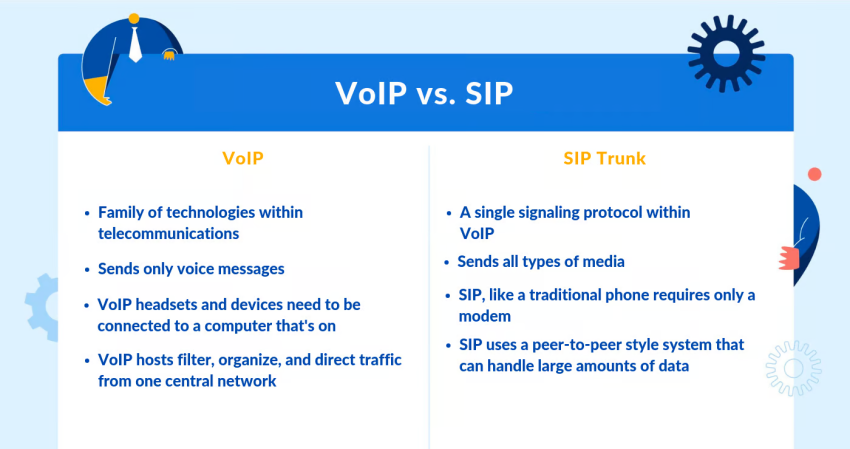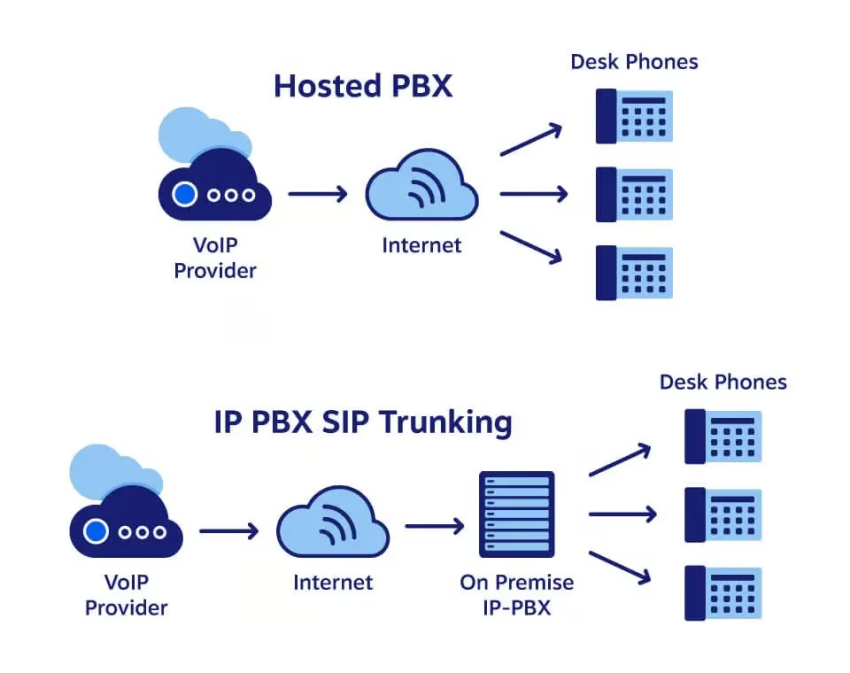How Much Does a SIP Trunk Cost?
A business SIP trunk channel costs between $15 and $25 per month for unlimited calling plans, or roughly $0.005 to $0.01 per minute for metered usage.
While cheap providers advertise rates as low as $0.004/min, the real cost hides in setup fees, expensive add-ons for E911 ($1.50/number), and porting charges. This guide breaks down the true cost of ownership so you can budget accurately.
What Is SIP Trunking?
Session initiation protocol (SIP) trunking is the technology for establishing and managing voice calls over the internet. A SIP trunk is the virtual connection that connects your office phone system (a local PBX) to the internet and the public switched telephone network. It’s a digital replacement for your traditional copper lines and PRI lines.
Watch: How SIP trunking acts as a digital backbone, replacing physical wires with cloud connectivity.

Why Is a SIP Trunk Better than Traditional Systems?
Many businesses are moving from older primary rate interface (PRI) lines and traditional TDM circuits to SIP trunks. Here’s how the systems compare and why SIP is better and more cost-effective.
| Feature | SIP Trunking | Traditional PRI |
|---|---|---|
| Technology | Digital (internet) | Physical (copper wires) |
| Cost | Low per-channel cost | High fixed cost per 23 lines |
| Scalability | Highly flexible (add 1 channel at a time) | Rigid (must buy in blocks of 23 lines) |
| Reliability | High, with easy call routing | High, but vulnerable to physical line cuts |
| Flexibility | Works over any internet connection | Tied to a physical location |
SIP Trunk Pricing 2026 (Models, Factors, and Ranges)
Your SIP trunking bill is determined by the pricing model you choose and several other important factors. Understanding these factors that influence account pricing is the first step toward getting volume pricing and the best rates.
Main SIP trunk pricing models
- Metered plans (pay per-minute): You pay a low monthly connection fee and are billed for each minute of inbound calls and outgoing calls. This approach can be cost-effective for businesses with low call volumes, but it can become expensive and unpredictable during busy periods.
- Unmetered/unlimited plans: This is the most popular SIP trunking model. You pay a fixed monthly price per channel, which includes unlimited calling to the US and Canada. Budgeting is easy and ideal for businesses with medium to high call volumes through predictable billing.
- Pay-as-you-go models: Some providers offer flexible pricing where you only pay for what you use, making it easier to manage campaign costs and variable usage patterns.

What is wholesale SIP trunking?
You’ll also come across the term “wholesale SIP trunking.” This is a high-volume, low-margin service with volume discounts designed for IT providers, resellers, and large enterprises that manage their own telecommunications infrastructure. For most businesses, standard plans from VoIP providers are the right choice.
Key cost factors that influence your SIP trunking bill
Before choosing a SIP trunk service, you should know the factors that affect SIP pricing and how they affect the total cost.
- Number of SIP channels: The more concurrent calls you need, the more channels you’ll pay for. This is the main factor in your base cost.
- Direct telephone numbers: Each direct inward dialing number (DID) and local number can cost between $1 and $2 per month. A one-time fee may apply to porting your existing numbers.
- Toll-free numbers: Incoming calls to a toll-free number usually have their own per-message charges, even with unlimited plans. Some providers require toll-free verification for certain services.
- Long-distance and call destination: With metered plans, international calls are billed at different rates depending on the country. Unlimited plans typically only cover calls within the US and Canada.
- Important add-ons: Beware of per-message charges for important services. Some providers charge extra for E911 service (legally required), caller ID (CNAM) transmission, call recording and analytics, call routing features, and fax services for existing fax systems.
- Setup fees: Some trunking providers charge one-time setup fees to activate your account or connect your PBX through their web portal.
Consider all these factors when planning your budget. Compare prices from different providers before choosing a SIP trunk plan, including monthly base fees, per-minute charges, and additional features you might need.
The Hidden Costs Most Quotes Leave Out
When comparing quotes, look for these line items that don’t appear until the first bill:
- E911 fees: Legally required for every physical address you register. Expect ~$1.50–$3.00 per DID.
- CNAM (caller ID) lookup: Some providers charge a fraction of a cent every time your phone receives a call with a name attached.
- Unlimited fair use policies: Most unlimited plans cap usage at 2,500 or 3,000 minutes per channel. If you run a call center, you’ll be billed for overage.
- International fraud protection: Some providers charge a premium for blocking international calls to high-risk countries. Ensure this security feature is included in your base rate.
SIP Trunk Pricing Calculator: How To Estimate Your Monthly Cost
You don’t need a complex tool to get a reliable cost estimate. Follow these simple steps.
1. Calculate your required channels
The most important factor is the maximum number of concurrent calls.
Rule of thumb: A good starting point is one channel per 3-4 employees. For an office with 30 employees, you’ll likely need 8-10 SIP channels. Better yet, check your current phone provider’s bill for your peak number of simultaneous calls and actual usage patterns.
2. Choose your pricing model
Look at your calling patterns and billing cycle preferences.
- Choose “metered” if your call volume is low (e.g., less than 1,000 minutes/month) and you rarely make long-distance calls.
- Choose “unmetered” if you have medium to high call volume and want predictable billing with unlimited calling.
3. Add up your numbers and features
List all the extras you’ll need through your web portal. How many individual phone numbers? Do you need toll-free numbers? Will you need call recording or fax services for incoming faxes and outbound faxes?
4. Create a sample estimate
Let’s calculate the estimated cost for a 40-person office that needs 12 channels and 40 phone numbers, choosing a typical unmetered plan.
- 12 Channels on Unmetered Plan (@ $24.95/channel): $299.40/month
- 40 Phone Numbers (DIDs) (@ $1/number): $40.00/month
- E911 Service (@ $1.50/number): $60.00/month
- Estimated monthly total: $399.40
Questions To Ask Every SIP Provider
Before contacting sales or signing a contract, use this checklist to get clear answers and avoid hidden fees.
Pricing and fees
- What is the total cost per channel per month?
- Are there mandatory setup fees, activation, or number porting costs?
- What are the exact per-minute rates for international countries I call frequently?
- Is E911 service included in the channel price, or separate per-number charges?
- Do you offer volume discounts for larger accounts?
Service features
- What call routing options are available?
- Do you support call recording capabilities?
- Can you handle incoming and outgoing calls efficiently?
- What fax services do you offer for our existing fax needs?
Reliability and support
- What is your network uptime guarantee or Service Level Agreement (SLA)?
- What kind of customer support is included (e.g., 24/7, phone, email)?
- Can I manage my account through a web portal?
Contracts and scalability
- What are the contract terms (e.g., month-to-month, annual)?
- How quickly can I add or remove SIP channels as needs change?
- Do you offer pay-as-you-go flexibility?
SIP Trunk Providers and Pricing Comparison
SIP trunk pricing and features can vary significantly across the market. Some providers offer clear and transparent pricing online, while others require custom quotes. Below is a comparison of the top SIP trunk providers for 2026, highlighting their pricing models and hidden fee structures.
| Provider | Pricing model | Best for | Typical unmetered price | Metered rates (outbound US) | Setup fees |
|---|---|---|---|---|---|
| Nextiva | Channel (unlimited) | Unified communications | ~$24.95/channel | $14.95/mo + ~$0.008/min | $0 |
| Twilio | Elastic (metered) | Developers/API | N/A (Elastic only) | ~$0.0053/min | $0 |
| Telnyx | Elastic (metered) | Global reach | N/A (Elastic only) | ~$0.005/min | $0 |
| SIP.us | Channel (unlimited) | Simple PBX | $24.95/channel | Unlimited Only | Varies |
| Flowroute | Elastic (metered) | Wholesale scale | Volume-based quotes | ~$0.005/min | $0 |
How to get the best SIP trunk pricing
Researching providers is half the battle. Follow these best practices to choose the right provider and get optimal rates.
- Choose the right plan: Don’t overpay for unlimited calling if your usage is low, and don’t risk high bills with pay-as-you-go if your usage is consistently high.
- Bundle services: Many VoIP service providers offer volume discounts if you bundle SIP with other services, such as video conferencing or contact center solutions.
- Negotiate contracts: When you contact sales, you may get better deals for longer-term contracts or by foregoing features you don’t need.
- Review actual usage: Monitor your billing cycle usage quarterly. If you regularly use fewer SIP channels than you pay for, ask your provider to adjust your plan through their web portal.
- Consider volume pricing: Larger businesses can negotiate better rates based on their concurrent call requirements and overall account message quantity.
Is SIP Trunking Right for You? (vs. Hosted VoIP)
Although both systems use VoIP, SIP trunking differs from a hosted, all-in-one business phone system.
SIP trunking is designed for businesses that already own and manage an on-premises PBX. It’s a technical solution connecting existing hardware to the cloud while maintaining your current setup for handling concurrent calls.
Hosted PBX or hosted VoIP is an all-in-one solution where the provider manages everything in the cloud. It’s ideal for businesses without their own PBX that want a simple, fully managed phone system.

If you’re considering hosted PBX and SIP trunking, here are the key differences and comparisons you should keep in mind:
- Cost of initial setup: Hosted PBX costs less if you have no on-premises PBX equipment; SIP trunking is more cost-effective if you already own equipment.
- Ongoing costs: Expect to pay between $15 and $60 per phone line per month, depending on your chosen pricing model and actual usage.
- Maintenance: Your VoIP provider handles maintenance and updates for hosted PBX systems.
- Company size: Hosted PBX systems work best for small businesses. SIP trunking excels for high-volume call environments requiring multiple concurrent calls.
- Call quality: Hosted PBX suits moderate call volumes, while SIP trunking handles high volume much better with proper PBX configuration.
- Advanced features: Both can offer call recording, call routing, and integration with existing fax systems, but implementation varies.
- Security: SIP trunking offers equivalent security features at a technical level, but a hosted PBX can be connected to Single Sign On, and call logs are readily available to IT admins.

SIP trunking typically requires that businesses be technical, and it can become complicated relatively quickly. It may also lack customer support that IT managers (and users!) need, though this depends on the provider.
It’s worth considering that the cloud phone system by Nextiva can offer all the advanced features, call uptime, customer support, and ease of use that growing businesses need.
Choose Nextiva for Simple, Transparent SIP Trunking
Nextiva isn’t just a simple phone line. We offer a hybrid solution. No complete system replacement is necessary. Nextiva’s SIP trunking integrates modern cloud features — such as mobile app access for remote employees — directly into your existing on-premises phone system. You benefit from the reliability of your proven hardware while simultaneously enjoying the flexibility of a future-proof cloud system.
Bring your PBX to the cloud — the easy way.
SIP trunking providers aren’t the same. Nextiva’s business voice network is built for reliability. There’s no new equipment needed.
SIP Trunk Pricing FAQs
Users on community forums like Reddit emphasize that the lowest price isn’t always best. Users warn about poor support, unreliable service, and hidden setup fees from low-cost providers. Most recommend choosing reputable providers with proven reliability and customer service, even if the monthly price is slightly higher.
SIP is the protocol for VoIP. A SIP provider is a specialized VoIP provider that focuses on selling the connection (the trunk) for a company’s own telephone system. Other VoIP providers sell hosted all-in-one phone systems where they manage the entire service, including phones and software.
Yes, most providers offer volume pricing for businesses with higher concurrent call requirements or longer-term contracts. When you contact sales, ask about volume discounts based on your account message quantity and expected usage patterns.
While some providers offer developers limited free trials of their services, there are no truly “free” SIP trunks for reliable business use. A functional SIP trunk requires infrastructure, support, and network access, all of which incur costs. Be wary of services that promise completely free business calls.
Setup fees range from $0 to several hundred dollars. Many providers waive these fees for longer contracts or higher-volume accounts. Always ask about setup fees when comparing total costs in your trunk pricing comparison.
This is a common point of confusion, but quite simple when you break it down:
SIP trunk: The central connection between your company and the SIP provider.
SIP line or channels: Individual capacity within your trunk. Each channel handles one concurrent call. If you need ten simultaneous calls, you need ten SIP channels.
Businesses choose SIP trunking for several key advantages:
– Allows companies to use existing hardware and phone systems
– Offers cost-effective voice service and scalability compared to traditional copper lines
– Handles multiple concurrent calls with multi-channel trunks
– Straightforward setup and maintenance with qualified IT support
– Attractive domestic and long-distance rates across the United States, Canada, and the United Kingdom
– Advanced call routing and call recording capabilities
– Integration with existing fax systems for both incoming faxes and outbound faxes
Set up a SIP trunk with these steps:
– Access your PBX software settings as an administrator
– Add credentials from your SIP trunk service provider, including username, password, phone numbers, and host/domain
– Configure call routing settings for inbound calls and outbound calls
– Test with a few calls in and out from a known working phone
– Access your provider’s web portal to monitor usage and manage your account
Most providers, like Nextiva, offer pre-configured setups to simplify the process and ensure the proper handling of concurrent calls from day one.

















 Business Communication
Business Communication 








